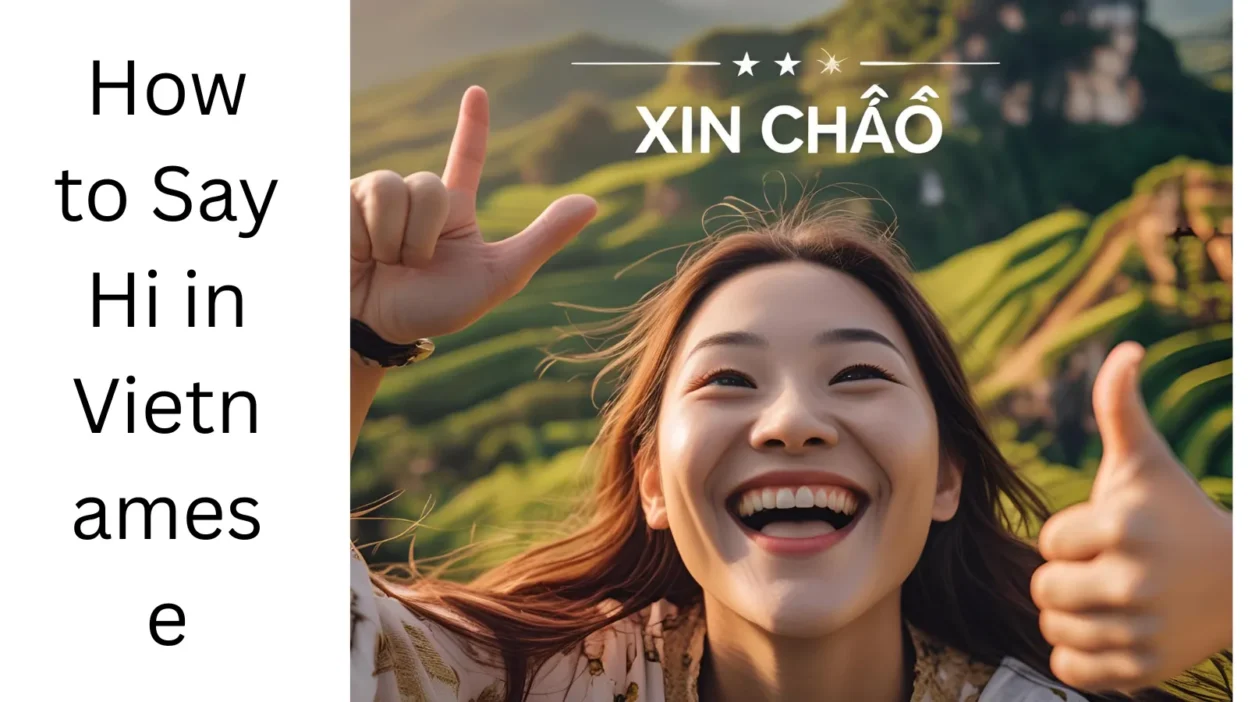If you’re learning Vietnamese, knowing how to say Hi in Vietnamese is one of the first and most useful things you can learn. Greeting someone properly helps you sound friendly, polite, and confident. In Vietnamese, there are different ways to say hi depending on the situation, so learning the right phrase makes your conversation natural and smooth.
Vietnamese greetings can vary by region, age, and social context, so using the right one shows cultural awareness. Get ready to make a great first impression, the Vietnamese way!
Say Hi in Vietnamese with Examples
In this guide, you’ll learn 15 friendly Vietnamese greetings—both formal and casual—along with pronunciation tips and example situations to help you sound natural and polite.
1. Xin chào – “Hello”
Origin:
The most neutral and formal greeting in Vietnamese. “Xin” is a polite particle (like “please”), and “chào” means “greet.”
Example:
👤 User A: Xin chào, tôi là Nam.
👤 User B: Xin chào, rất vui được gặp bạn!
Use: Formal and polite. Safe for any situation, especially with strangers or in business.
2. Chào bạn – “Hi, friend”

Origin:
“Chào” means “hi,” and “bạn” means “friend” or “you” (for someone around your age).
Example:
👤 User A: Chào bạn! Hôm nay bạn thế nào?
👤 User B: Mình ổn, cảm ơn bạn nhé!
Use: Casual, friendly; used with peers.
3. Chào anh – “Hi, older brother”
Origin:
“Anh” is used to address a slightly older male. Vietnamese culture heavily values age hierarchy.
Example:
👤 User A: Chào anh, em mới đến.
👤 User B: Chào em! Vào nhà đi.
Use: Polite and respectful when speaking to a slightly older male.
4. Chào chị – “Hi, older sister”
Origin:
“Chị” is the respectful term for an older female.
Example:
👤 User A: Chào chị, em là học sinh mới.
👤 User B: Chào em! Chào mừng em đến lớp.
Use: Respectful greeting for an older female, often in school or workplace settings.
5. Chào em – “Hi, younger person”
Origin:
“Em” is used for someone younger than you. It can sound sweet or even flirty, depending on tone.
Example:
👤 User A: Chào em! Em học ở đâu vậy?
👤 User B: Dạ, em học ở Đại học Quốc gia.
Use: Used by older speakers to greet someone younger.
6. Chào cô – “Hi, Miss / Teacher”

Origin:
“Cô” refers to a female teacher or an older woman.
Example:
👤 User A: Chào cô ạ!
👤 User B: Chào con, học tốt nhé!
Use: Very polite; used for female authority figures or older women.
7. Chào chú – “Hi, Uncle”
Origin:
“Chú” is a respectful term for a man older than you, especially if he’s your parents’ age.
Example:
👤 User A: Chào chú, cháu mới đến.
👤 User B: Chào cháu, vào chơi đi!
Use: Polite greeting for older males.
8. Chào thầy – “Hi, Teacher (Male)”
Origin:
“Thầy” specifically means male teacher or a respected male mentor.
Example:
👤 User A: Chào thầy!
👤 User B: Chào em, em có câu hỏi gì không?
Use: Formal and respectful greeting to a male teacher.
9. Chào con – “Hi, child”

Origin:
“Con” is how an elder (like a parent or grandparent) would greet a younger person, especially a child.
Example:
👤 User A: Chào con yêu!
👤 User B: Con chào mẹ ạ!
Use: Affectionate, used by adults speaking to children.
10. Dạ, chào cô/chú/thầy… – “Yes, hello…”
Origin:
“Dạ” is a polite particle showing respect before a greeting. Very traditional.
Example:
👤 User A: Dạ, chào chú ạ!
👤 User B: Ừ, cháu ngoan lắm!
Use: Extra respectful; often used by children, students, or in formal greetings.
11. Ê! – “Hey!”
Origin:
Very informal, used among close friends. Similar to “Hey!” in English.
Example:
👤 User A: Ê, mày làm gì đó?
👤 User B: Ê! Đang chơi game nè.
Use: Slang/informal; only with close friends of same age.
12. Này! – “Hey!”
Origin:
Another attention-getter like “Ê,” but slightly softer. Used to call someone over.
Example:
👤 User A: Này, cậu quên cặp kìa!
👤 User B: Ôi, cảm ơn nha!
Use: Informal, but can be helpful or friendly.
13. A lô – “Hello (on the phone)”
Origin:
Vietnamese equivalent of “Hello?” on the phone. Borrowed from the French “Allô.”
Example:
👤 User A: A lô, Linh nghe đây.
👤 User B: A lô! Mình là Hoa, gọi nhầm số rồi!
Use: Only used during phone calls.
14. Chào mọi người – “Hi everyone”
Origin:
“Mọi người” means “everyone.” It’s used to greet a group of people.
Example:
👤 User A: Chào mọi người! Rất vui được gặp các bạn!
👤 User B: Chào bạn! Chào mừng đến với lớp học.
Use: Casual to semi-formal; great for group settings or public speaking.
15. Lâu quá không gặp! – “Long time no see!”
Origin:
Borrowed from the English phrase; often used to greet someone after a long time apart.
Example:
👤 User A: Ôi, lâu quá không gặp!
👤 User B: Ừ! Nhớ bạn quá trời luôn!
Use: Warm and nostalgic; used when reconnecting.
FAQs
- What is the common way to say hi in Vietnamese?
The most common word is “Xin chào.” - How do you pronounce “Xin chào”?
It’s pronounced sin chow. - Is “Xin chào” formal or informal?
It’s neutral — polite and safe for most situations. - How do you say hi to friends casually in Vietnamese?
You can say “Chào” alone in informal situations. - Can I use “Xin chào” with elders or strangers?
Yes, it’s polite and respectful for anyone. - How do I say hi in a text message in Vietnamese?
You can write “Chào” or “Xin chào” depending on the formality. - Are there different hi phrases for morning or evening?
Yes, you can say “Chào buổi sáng” (Good morning) or “Chào buổi tối” (Good evening). - Can I use “Xin chào” in a professional setting?
Yes, it’s polite enough for work, meetings, or emails. - How do you respond when someone says “Xin chào”?
Simply reply “Xin chào” back with a smile. - Is “Xin chào” used in all Vietnamese-speaking regions?
Yes, it’s widely understood across Vietnam.
Conclusion:
How to Say Hi in Vietnamese goes beyond just one phrase—it opens the door to respectful and meaningful communication. With these 15 greetings, you can now confidently say hello in both casual and formal situations, whether you’re meeting friends, elders, or new acquaintances.
Learning how to greet someone properly is one of the best ways to show cultural respect and start any interaction on a positive note.
Want to keep expanding your Vietnamese vocabulary? Check out our guide on How to Say Thank You in Vietnamese and take your politeness to the next level!



